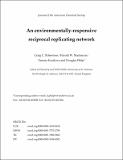Files in this item
An environmentally responsive reciprocal replicating network
Item metadata
| dc.contributor.author | Robertson, Craig C. | |
| dc.contributor.author | Mackenzie, Harold W. | |
| dc.contributor.author | Kosikova, Tamara | |
| dc.contributor.author | Philp, Douglas | |
| dc.date.accessioned | 2019-05-08T23:37:16Z | |
| dc.date.available | 2019-05-08T23:37:16Z | |
| dc.date.issued | 2018-06-06 | |
| dc.identifier | 253077101 | |
| dc.identifier | 3674eacf-8f6a-49d8-8cb1-322e12602dac | |
| dc.identifier | 85046971103 | |
| dc.identifier | 000434895200022 | |
| dc.identifier.citation | Robertson , C C , Mackenzie , H W , Kosikova , T & Philp , D 2018 , ' An environmentally responsive reciprocal replicating network ' , Journal of the American Chemical Society , vol. 140 , no. 22 , pp. 6832-6841 . https://doi.org/10.1021/jacs.7b13576 | en |
| dc.identifier.issn | 0002-7863 | |
| dc.identifier.other | ORCID: /0000-0002-9198-4302/work/56639227 | |
| dc.identifier.uri | https://hdl.handle.net/10023/17673 | |
| dc.description | The financial support for this work was provided by EaStCHEM and the Engineering and Physical Sciences Research Council (Grant EP/K503162/1). | en |
| dc.description.abstract | A reciprocal replication system is constructed from four building blocks, A , B , C , and D , which react in a pairwise manner through either a 1,3-dipolar cycloaddition or the condensation reaction between an amine and an aldehyde to create two templates, trans-TAB and TCD. These templates are equipped with complementary recognition sites—two carboxylic acids (trans-TAB) or two 4,6-dimethylamidopyridines (TCD)—that enable each template to direct the formation of its complementary partner through two mutually-reinforcing cross-catalytic pathways, in which the templates trans-TAB or TCD preorganize the appropriate building blocks within two catalytically-active ternary complexes: [C•D•trans-TAB] and [A•B•TCD]. The template-directed processes within these complexes generate a heteroduplex [trans-TAB•TCD], which is shown to possess significant stability through kinetic simulations and fitting. As a consequence, the individual cross-catalytic pathways perform more efficiently in template-directed experiments when the concentration of the template being formed is below that of the template added as instruction. Comprehensive analysis of the system in which A , B , C , and D are mixed together directly, using a series of 1H NMR spectroscopic kinetic experiments, demonstrates that the behavior of the reciprocal system is more than the simple sum of its parts—as part of the interconnected network, the product of each reaction clearly directs the fabrication of its reciprocal partner, facilitating both higher rates of formation for both templates and improved diastereoselectivity for trans-TAB. A simple change in experimental conditions (from dry to "wet" CDCl3) demonstrates the sensitivity of the replication pathways within the network to the reaction environment, which leads to a >10-fold increase in the contribution of a new minimal self-replicator, trans-TAB*, to the replication network. | |
| dc.format.extent | 10 | |
| dc.format.extent | 5648151 | |
| dc.language.iso | eng | |
| dc.relation.ispartof | Journal of the American Chemical Society | en |
| dc.subject | QD Chemistry | en |
| dc.subject | DAS | en |
| dc.subject | BDC | en |
| dc.subject | R2C | en |
| dc.subject.lcc | QD | en |
| dc.title | An environmentally responsive reciprocal replicating network | en |
| dc.type | Journal article | en |
| dc.contributor.institution | University of St Andrews. School of Chemistry | en |
| dc.contributor.institution | University of St Andrews. Office of the Principal | en |
| dc.contributor.institution | University of St Andrews. EaSTCHEM | en |
| dc.contributor.institution | University of St Andrews. Biomedical Sciences Research Complex | en |
| dc.identifier.doi | 10.1021/jacs.7b13576 | |
| dc.description.status | Peer reviewed | en |
| dc.date.embargoedUntil | 2019-05-09 |
This item appears in the following Collection(s)
Items in the St Andrews Research Repository are protected by copyright, with all rights reserved, unless otherwise indicated.

